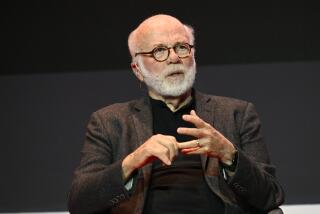NEA Chief Defends Her Grant Vetoes : Endowment: Acting chairman Anne-Imelda Radice discusses the controversy that has surrounded her short tenure.
- Share via
SACRAMENTO — “I’m the head of a federal agency that has a responsibilty to the taxpayer. And the taxpayer has been pretty vocal about what he or she feels about everything, including the arts.”
With those words, Anne-Imelda Radice, acting chairman of the National Endowment for the Arts, characterized her approach to the job she inherited a month ago.
In an interview following her appearance Wednesday on a panel at the second annual Governor’s Conference on the Arts here, Radice spoke at length about the controversy that has surrounded her short tenure--controversy arising from her vetoing of two grants that had been recommended by an NEA peer panel and the advisory National Council on the Arts.
Echoing remarks she made before a recent congressional committee, Radice said she believes that while the feelings of panels and council should be considered, the chairman must take the ultimate responsibility for making decisions. She stressed that she is a White House appointee chosen to serve a federal agency in what she believes to be the best interest of Congress and the American people.
Speaking critically of her predecessor, John E. Frohnmayer--ousted from his post in February during attacks on the NEA by then-presidential hopeful Pat Buchanan--Radice said Frohnmayer was sincere in saying what he felt, but gave too much authority to advisory panels and “was unwilling to accept . . . the legal role of the chairman.”
“The panel is advisory, the council is advisory. The chairman makes the decision,” she said. “For the past three years or so, there has been the perception that . . . any non-acceptance of advice by either council or panels is some kind of heretical action. That’s absolutely ridiculous.”
Radice’s appearance at the conference was on a session addressing the arts and economic development. Her brief comments before an audience of approximately 200 artists and administrators included no references to recent NEA turmoil. In a question-and-answer session as part of the panel, one audience member asked her about the overturned grants, but she declined to address the issue, saying it wasn’t what she was there to discuss.
While Radice was in Sacramento, a House Appropriations Committee meeting in Washington heard testimony from the arts community, which included complaints against Radice from members of two peer panels who recently refused to carry out their duties in protest of Radice’s decision to deny grants for exhibitions at the Massachusetts Institute of Technology’s List Gallery and Virginia Commonwealth University’s Anderson Gallery.
In the interview, Radice--who was unavailable for comment during the walkouts by panels reviewing applications for fellowships to sculptors and solo theater artists--adamantly defended both her decision and her right to overturn the grants.
“I explained this to (the solo theater artists panel) last week,” said the 44-year-old Radice. “I said, ‘That’s the way Congress set it up.’ If you don’t agree with it, I hate to say write your congressman, but that’s where it is. I am a person with feelings, a person who clearly has been given a responsibility that’s pretty heavy-duty. I don’t represent a private foundation investing my own personal money. I’m no longer the director of a private museum,” added Radice, who at one point served as director of the National Museum of Women in the Arts in Washington.
Radice said the NEA has not bowed to pressure groups that have protested certain controversial NEA funding decisions in the past and does not like to characterize them as the “religious right.”
“I think it’s disrespectful to pick out any group and stick a label on them that’s derogatory,” she said. “These are American citizens who are expressing their rights.”
Radice believes she gave due consideration to the peer panel recommendation for grants to the List and Anderson galleries for proposed exhibitions which would include depictions of body parts and sexual organs. “The (peer panel) that recommended the two grants that I did not accept made over 400 recommendations--I didn’t agree with two of them, that’s all,” she said. “We’re investing relatively limited resources, and we have to make the best investment.
“In 99.999% of cases, I’m not going to disagree (with the panels). And the few instances where I might disagree I don’t think is cause for the end of the world, or some of the reaction that I’ve gotten. I don’t think people have to agree, but to call me a censor or say that I don’t care or that I don’t respect the panel, it’s abhorrent to me. That’s not the kind of person that I am.”
While some members of the solo performance theater panel have said Radice refused to discuss their concerns, Radice says she met with panel members in her office and “begged them to stay” and finish their review so the artists involved would not lose their grants. “We were willing to stay all night if they were willing to,” she said.
Radice added that once the delays had occurred, it was impossible to delay further or get a new panel due to the logistics, time and expense which it would have involved. The $210,000 in grant money slated for solo theater performance artists will be distributed to other programs.
Radice said the meeting with the panel “was not a pretty sight . . . you could see a lot of anguish and anger, which I respected. They demanded to know my criteria. I said, ‘Look, I have been up front with everybody who has asked me, and this has nothing to do with your panel.’ I said I did not feel that those two grant applications were as impressive as the others that were recommended for funding. The theme that was involved was a theme that has been treated by other shows.
“They were trying to push me into a corner, saying, ‘The reason you don’t want the show is because of the isolation of some of the body parts.’ I tried to explain to them that subject matter is one part of a whole artistic analysis . . . I’m talking about federal money now, I’m not talking about a gallery taking a risk as a private gallery, I’m talking about U.S. federal dollars; I did not feel that these two shows deserved national sponsorship, and I said this in 198 different ways . . . clearly they were not impressed with that answer.”
Radice denied that the NEA dismissed the solo theater performance panel because grants in that category have caused controversies in the past. The so-called “NEA 4,” a group of performance artists suing the endowment over grants that were recommended then vetoed in 1990, fell into that category.
Referring to a past NEA grant that aroused controversy, Radice said that while she supports NEA funding for shows by “important” artists such as Robert Mapplethorpe, she would like to have the option of vetoing support for certain works if they do not meet her artistic criteria. “I would have been absolutely up front and suggested that (his works be displayed) in two shows, one with government funding and one with private funding,” she said.
Radice said she does not believe the peer panel protests will spark more walkouts. “It’s not like it was a mass exodus,” she said. “There were three other panels meeting that week, and they all met.
“We can’t afford to let a couple of grant applications or somebody’s impassioned speeches on a subject lead us around.”
Radice said that in the past several years the NEA has lost the public’s trust and that her job is to win back that trust with firm leadership. “If we can keep doing our jobs and get the public behind us again, I think (the NEA) will be here, and we will be ready for re-authorization, which comes up next year,” she said.
Radice said she “loves all kinds of art” and collects contemporary and Renaissance works. She said she is not campaigning for the position of permanent NEA chair, which will be named after the presidential election. She added that her current position as acting chair was mandated by Congress, since the person who is second in command at the agency is obliged to step in if the chairman cannot serve or resigns.
“I’m an appointee, so I go where I’m sent,” Radice said. “If I’m needed there, I’ll be there . . . When you sign on, you just do .”
More to Read
The biggest entertainment stories
Get our big stories about Hollywood, film, television, music, arts, culture and more right in your inbox as soon as they publish.
You may occasionally receive promotional content from the Los Angeles Times.










